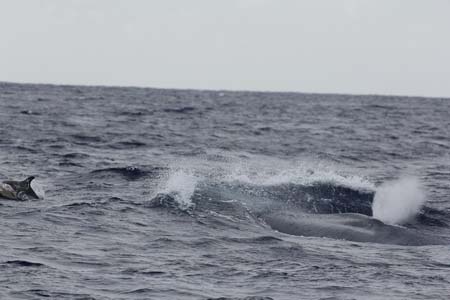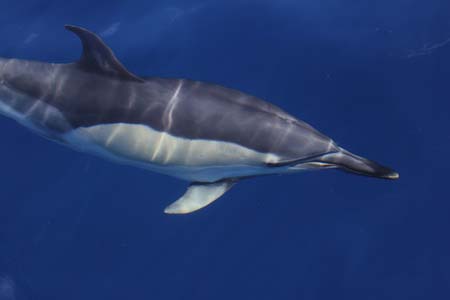Today (3rd May) sees the last day of the Azores leg of our Atlantic research project. It’s really been a great few weeks, of productive research, amazing cetacean sightings, a brilliant crew and kind weather (well, mostly…we are in the middle of the Atlantic after all…).
Over the past week, we’ve had some wonderful experiences, on land as well as sea. Our final week began with a return to harbour in Horta. The weather had conveniently decided to throw a tantrum on the same day that we needed to go back to land anyway, to pick up new crew (Sigursteinn, from IFAW, Iceland) and parts for our hydrophones. So we made a run for port, buffeted by fresh winds and lumpy seas. Although on the plus side, the squally weather made for great rainbows, and the fresh snow on Pico looked stunning in the sunshine.
By the afternoon, the skies had cleared enough to allow Sonia, Artist in Residence from the Cape Farewell project, to get on with some beach art. Sonia has been working on a project drawing life-sized pictures of endangered whale species on beaches. We all loved her work, and were delighted when she agreed to draw a massive sperm whale on the beach at Porto Pim, the bay where sperm whales used to be brought to shore in the Azores whaling days. The factory there is now a whaling museum, and the sperm whale she drew on the beach in front of it was beautiful and moving.
Once back out to sea, we headed for Princesse Alice Bank, an area of sea mounts 50 miles southwest of Faial, where we hoped to encounter baleen whales to photo-identify them, and record their low frequency vocalisations. On passage through the night, there was frenzied vocal activity on our hydrophones, with the headphones filled with delphinid whistles and clicks. Our hopes were high as the morning came still and calm, but the day was mostly quiet on the sightings front apart from our ever-present and constantly entertaining companions the common dolphins. We also had an amazing sperm whale encounter, the animal logging and blowing close to our boat, then fluking up and posing elegantly for ID shots before diving, clicking into our hydrophones as it went.
But the whale action was only going to get better. Since we have been in the Azores, we have seen and recorded some ten species of whales and dolphins. But the blue whale, the largest of them all, and a key focus of our Atlantic research program this summer, has eluded us. But not forever. Yesterday Catherina, one of our Portuguese interns who is studying at the University in the Azores, and who also works for one of the local whale watch companies, heard that blues whales were being seen south of Pico. We diligently searched the area, assisted by the hilltop vigia, who search for whales for the whale watching operations. We looked and looked…but nothing. The sea was far from flat, but really – the largest animal in the world – how hard could it be?! But then BLOW! And BLOW! again, and we had found our animal. Or at least we found its blows, but although we tracked it closely, we struggled to see the animal iteself. Until suddenly it surfaced, bursting from the water just a few metres from the beam of our boat, the water streaming off its muscular sides, and a huge blow . We watched as, between surfacings, it could clearly be seen underwater, the most perfect, immense bright turquoise shadow just below the water. But then we realised there was more than one animal nearby . Three we thought, one of which also surfaced right by us, this time accompanied by half a dozen common dolphins, bowriding the whale rather than our vessel for a change. Well, why would you waste your energy on a boat, when you could play with a 30 metre whale? Not sure what the whale thought of it though…

By the end of the day we were exhausted and delighted, with some excellent photo-identification images and we hope some good recordings of their vocalisations. The day made for a spectacular finale to our Azores survey. We shall be sorry to move on, but are excited about what lies ahead as we cross the Atlantic…
Susie

Sorry, comments are closed for this post.